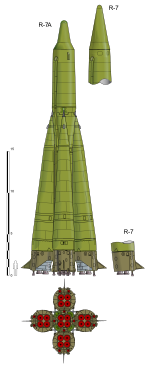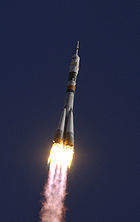
An intercontinental ballistic missile (ICBM) is a ballistic missile with a range greater than 5,500 kilometres (3,400 mi), primarily designed for nuclear weapons delivery. Conventional, chemical, and biological weapons can also be delivered with varying effectiveness, but have never been deployed on ICBMs. Most modern designs support multiple independently targetable reentry vehicle (MIRVs), allowing a single missile to carry several warheads, each of which can strike a different target. The United States, Russia, China, France, India, the United Kingdom, Israel, and North Korea are the only countries known to have operational ICBMs. Pakistan is the only nuclear-armed state that does not possess ICBMs.

The R-7 Semyorka, officially the GRAU index 8K71, was a Soviet missile developed during the Cold War, and the world's first intercontinental ballistic missile. The R-7 made 28 launches between 1957 and 1961. A derivative, the R-7A, was operational from 1960 to 1968. To the West it was unknown until its launch. In modified form, it launched Sputnik 1, the first artificial satellite, into orbit, and became the basis for the R-7 family which includes Sputnik, Luna, Molniya, Vostok, and Voskhod space launchers, as well as later Soyuz variants. Various modifications are still in use and it has become the world's most reliable space launcher.
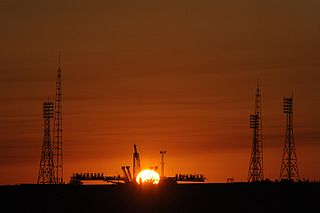
The Baikonur Cosmodrome is a spaceport operated by Russia within Kazakhstan. Located in the Kazakh city of Baikonur, it is the largest operational space launch facility in terms of area. All Russian crewed spaceflights are launched from Baikonur.

Plesetsk Cosmodrome is a Russian spaceport located in Mirny, Arkhangelsk Oblast, about 800 km north of Moscow and approximately 200 km south of Arkhangelsk. As of 2024, it is Europe's only operational orbital spaceport and the northernmost spaceport in the world. Originally developed as an ICBM site for the R-7 missile, it also served for numerous satellite launches using the R-7 and other rockets. Its high latitude makes it useful only for certain types of launches, especially the Molniya orbits, so for much of the site's history it functioned as a secondary location, with most orbital launches taking place from Baikonur, in the Kazakh SSR. With the end of the Soviet Union, Baikonur became a foreign territory, and Kazakhstan charged $115 million usage fees annually. Consequently, Plesetsk has seen considerably more activity since the 2000s.
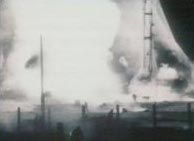
The Nedelin catastrophe or Nedelin disaster, known in Russia as the Catastrophe at Baikonur Cosmodrome, was a launch pad accident that occurred on 24 October 1960 at the Baikonur Cosmodrome in Soviet Kazakhstan. As a prototype of the R-16 intercontinental ballistic missile was being prepared for a test flight, an explosion occurred when the second stage engine ignited accidentally, killing an unknown number of military and technical personnel working on the preparations. Despite the magnitude of the disaster, information was suppressed for many years and the Soviet government did not acknowledge the event until 1989. With more than 54 recognized casualties, it is the deadliest disaster in space exploration history. The catastrophe is named for the Chief Marshal of Artillery Mitrofan Ivanovich Nedelin, who was the head of the R-16 development program and perished in the explosion.

The Strategic Rocket Forces of the Russian Federation or the Strategic Missile Forces of the Russian Federation is a separate-troops branch of the Russian Armed Forces that controls Russia's land-based intercontinental ballistic missiles (ICBMs). It was formerly part of the Soviet Armed Forces from 1959 to 1991.
The R-16 was the first successful intercontinental ballistic missile deployed by the Soviet Union. In the West it was known by the NATO reporting name SS-7 Saddler, and within Russia, it carried the GRAU index 8K64.

The RT-2PM Topol was a mobile intercontinental ballistic missile designed in the Soviet Union and in service with Russia's Strategic Missile Troops. As of 2014, Russia planned to replace all RT-2PM ICBMs with versions of Topol-M. In December 2023, the last Topol regiment was taken off combat duty.

Kapustin Yar is a Russian military training area and a rocket launch complex in Astrakhan Oblast, about 100 km east of Volgograd. It was established by the Soviet Union on 13 May 1946. In the beginning, Kapustin Yar used technology, material, and scientific support gained from the defeat of Germany in World War II. Numerous launches of test rockets for the Russian military were carried out at the site, as well as satellite and sounding rocket launches. The towns of Znamensk and Kapustin Yar were built nearby to serve the missile test range.

The R-9 was a two-stage IRBM of the Soviet Union, in service from 1964 to 1976.

The R-14 Chusovaya was a single stage Intermediate-range ballistic missile developed by the Soviet Union during the Cold War. It was given the NATO reporting name SS-5 Skean and was known by GRAU index 8K65. It was designed by Mikhail Yangel. Chusovaya is the name of a river in Russia. Line production was undertaken by Facility No. 1001 in Krasnoyarsk.

The R-12 Dvina was a theatre ballistic missile developed and deployed by the Soviet Union during the Cold War. Its GRAU designation was 8K63, and it was given the NATO reporting name of SS-4 Sandal. The R-12 rocket provided the Soviet Union with the capability to attack targets at medium ranges with a megaton-class thermonuclear warhead and constituted the bulk of the Soviet offensive missile threat to Western Europe. Deployments of the R-12 missile in Cuba caused the Cuban Missile Crisis in 1962. A total of 2335 missiles were produced; all were destroyed in 1993 under the START II treaty.

Kura Missile Test Range, originally known as Kama, is a Russian intercontinental ballistic missile impact area located in northern Kamchatka Krai in the Russian Far East. It is the destination for ballistic missiles which are test fired from other centers, and was chosen due to its remoteness and distance. It is 130 kilometers (81 mi) northeast of the settlement of Klyuchi and the military townlet is called Klyuchi-1, after the nearest settlement.

The RS-24 Yars also known as Topol-MR, NATO reporting name SS-29 or SS-27 Mod 2), is a Russian MIRV-equipped, thermonuclear armed intercontinental ballistic missile first tested on May 29, 2007, after a secret military R&D project.

Baikonur Site 31, also known as Site 31/6 at the Baikonur Cosmodrome, in Kazakhstan, is a launch site used by derivatives of the R-7 Semyorka missile. Since Roscosmos' change from flying crew on the Soyuz-FG to the Soyuz-2 launch vehicle for crewed flights in 2020, it has served as the primary launch site for Soyuz flights to the International Space Station. It took over from Site 1/5 after the latter failed to receive funding to modernize it for the slightly larger Soyuz-2 rocket.

The R-7 family of rockets is a series of rockets, derived from the Soviet R-7 Semyorka, the world's first intercontinental ballistic missile (ICBM). More R-7 rockets have been launched than any other family of large rockets.
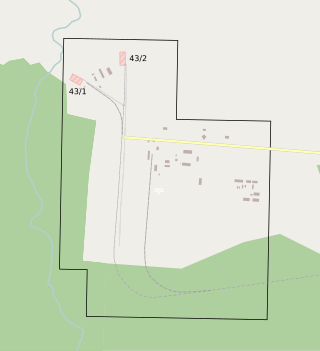
Site 43, also known as SK-3 and SK-4, is a launch complex at the Plesetsk Cosmodrome in Russia. It consists of a two pads, Sites 43/3 and 43/4, and has been used by R-7 derived rockets since the early 1960s.
The RS-28 Sarmat, often colloquially referred to as Satan II by media outlets, is a three-stage Russian silo-based, liquid-fueled, HGV-capable and FOBS-capable super-heavy intercontinental ballistic missile (ICBM) produced by the Makeyev Rocket Design Bureau. It is intended to replace the Soviet R-36M ICBM in Russia's arsenal.

Site 41 was a complex of three launch pads at the Baikonur Cosmodrome originally built for flight testing of Intercontinental ballistic missile (ICBMs) using storable propellant. The need to develop such missiles was determined by low-tactical-technical and operational characteristics of the first Soviet ICBM R-7 created by the OKB-1 under the guidance of Sergei Pavlovich Korolev. May 13, 1959 by a special decree of the Central Committee of the CPSU and the CM of the design Bureau «Yuzhnoye» assigned to develop an Intercontinental ballistic missile on storable components of propellant, which has received designation R-16 and index – 8К64. Together with 41 platform built platform No. 42 – technical and No. 43 – for residing of serving military personnel and representatives of the industry.
System A-235 PL-19 Nudol is a Russian hypersonic anti-ballistic missile and anti-satellite weapon system in development. It is designed to deflect a nuclear attack on Moscow and other regions within European Russia. The main developer of the system is JSC Concern VKO Almaz-Antey. The new system should replace the current one — A-135. The two main differences will be that the A-235 will use conventional warheads and it will be road-mobile.
